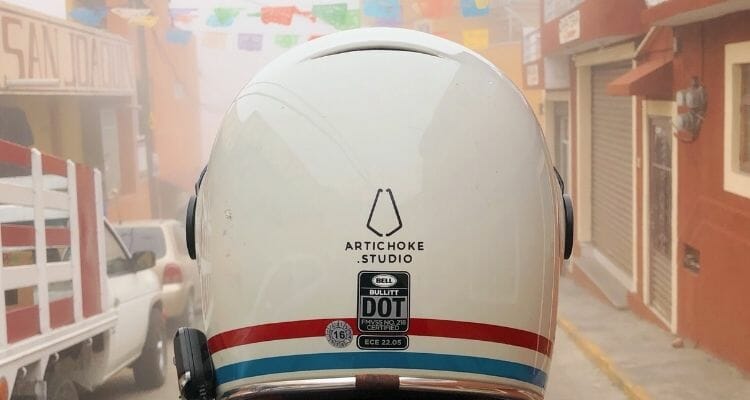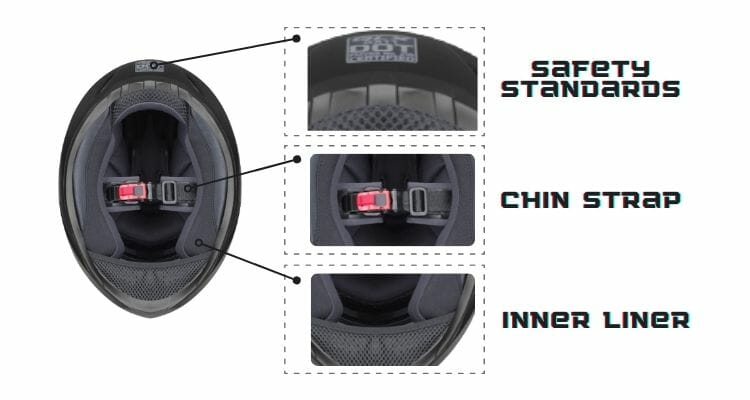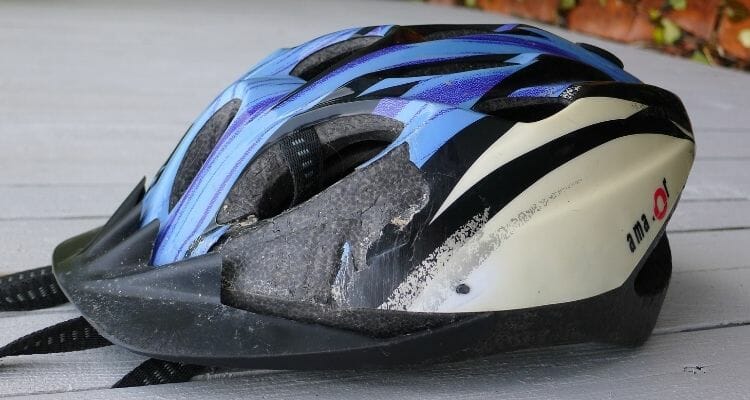Every new helmet buyer should keep in mind that a purchased helmet cannot always be with them. Motorcycle helmets expire due to wear and tear spanning several years or maybe immediately become unusable due to an accident. In either case, you will have to replace it.
So they need to know do motorcycle helmets go bad and what are the things that cause a helmet to degrade its performance?
However, you may need to purchase a new helmet in most cases. For example, if you get into an accident and break your old helmet, you may not be able to get another if its warranty has expired.
If you do not see any markings on the inside of the shell, it could mean that the manufacturer has not yet received the proper certification. You may need to find an approved replacement for your old helmet, or if you are lucky, the original manufacturer may sell a replacement.
If you are looking for the best protection for your head, you should look at the helmet’s rating and test its characteristics thoroughly.
Table of Contents
- 1 Check the protective characteristic of helmets.
- 2 When do motorcycle helmets expire
- 3 How long are helmets good for
- 4 How to lengthen the life span
- 5 Is there an expiry date mentioned on motorcycle helmets
- 6 Why you should replace the motorcycle helmet
- 7 How often should a helmet be changed?
- 8 Conclusion
- 9 FAQ:
Check the protective characteristic of helmets.
Did you know that not all helmets are created equal by helmet manufacturers? Some just last a little longer than others. The longer the helmet lasts, the more likely it will become unsafe. But how to tell if the helmets are possibly degrading performance?
New helmets wear out over time, and just like shoes or clothing, when you wear a helmet regularly, different parts of the helmet start to fatigue and lose their protective characteristics. Once the helmet expires, you just need to know what to do with the old motorcycle helmet.

If you have never been in an accident or have only ridden a short distance on the road, it is important to understand how to test old or expired helmets properly.
Helmets will fail when they become unsafe, and they start to lose their protective characteristic. This may be because of improper fitting, improper use, or due to a manufacturing defect.
When helmets degrade due to external factors, the parts that affect the most are below.
Outer Shell
The outer shell of a helmet is usually made from fiberglass, Kevlar, or carbon fiber. The most commonly used material is strong and lightweight, which makes them ideal for motorcycle helmets. However, over time, these materials can degrade and become weaker. sunlight, chemicals, and extreme temperatures can all cause the degradation of helmet materials.
A good way to check the helmet degradation is to look for cracks and other signs of wear and tear on the helmet’s outer shell. If the helmet is starting to show signs of wear, it is important to replace it as soon as possible.
Helmets are proven to save lives and prevent head injuries, but they deteriorate with microscopic cracks developing over time in the helmet’s outer shell.
These minor cracks can worsen and eventually lead to gigantic clefts in the shells that lead to head wounds.
The cracks develop due to ultraviolet light, friction, durability, and stress. Helmet degradation also includes prolonged UV exposure to different climatic and weather conditions.
The best way to prevent a severe head injury is to inspect your helmet regularly, and if you notice any cracks, do not use the helmet anymore. The shell cracks indicate the helmet is expired.
EPS (Expanded Polystyrene)
The EPS liner protects from impact energy in a crash due to its excellent shock absorbing characteristics. Over time, the EPS liner can expire and lose its ability to absorb the force of the blow in a crash due to exposure to UV light and moisture.
You can check the EPS liner by looking for cracks or small holes. If you see any damage, it is time to replace your helmet. You should replace your helmet after a couple of years, even if you haven’t crashed in it.
You can always check the replacement guidelines in the article “things to consider before buying a motorcycle helmet“.
Inner liner or Comfort Padding in the helmet
The comfort padding is placed inside the helmet shell, and it is available in many different types and thicknesses. It is a soft, plush inner lining that protects the head from impact. The inner lining helps to provide the best fitting to the rider and absorbs excessive sweat in hot weather. However, sweat and other body fluids affect liner materials and cause their degradation.
Over time the helmet padding becomes odorous due to the accumulation of oil, dirt, and sweat. Padding inside helmets can degrade over time, which can impact the fit of the helmet and reduce the level of safety.
Helmet manufacturer provide expiry date sticker stitched on the helmet padding with other specifications labeled on it.
Chin Straps
The chin strap is one of the most important parts of the helmet, and it is also one of the most vulnerable to degradation. Over time, it can become frayed and weak, leading to the helmet coming off in an accident.
The chin straps are made of polypropylene, and they can be replaced if it becomes damaged. They can be repaired by cutting off the damaged part of the strap and sewing it back on with a new piece of the chin strap.
However, if the screws with which the chin strap is attached to the helmet become loose or cannot be tightened properly, the helmet must be replaced because a failed retention system can cause the slip of the helmet at high speed.
When do motorcycle helmets expire
The lifespan of a helmet can depend on many factors, from how often it is used to how well it is cared for. However, most motorcycle helmets expire late and need to be replaced after 3-5 years of use.
How long are helmets good for
The answer to this question depends on how you use your helmet. If it is worn and abused, it will lose its protective characteristics earlier than the expiration date. However, if it is used properly, the helmet will last a much longer time but a five year helmet replacement plan is recommended by the Snell foundation.
The lifetime of a particular helmet depends largely on the quality of the materials used in helmet production by its manufacturer. Some motorcycle helmets expire early because of subgrade material used in their construction.
The first step in assuring the quality of your helmet is to check its safety rating for the helmet. The ANSI Z84.1 standard for motorcycle helmets requires that all helmets be Sealed against penetration by foreign objects and Provide protection against impact from a motor vehicle. It should have a minimum energy absorption rate of at least 40%.
How to lengthen the life span
Now I will detail how to take care and what maintenance you should do to ensure the lifetime of your helmet. There are many things you can do to extend the life of your helmet.
Standards from reputable manufacturers
One important factor in how long a helmet lasts is how it is made. The most important thing that you need to check on your helmet is to make sure that it contains the safety standards marked by the manufacturer at the time of helmet production.
Many helmets that meet the standards will last longer than a helmet that does not.

For instance, Snell and DOT both are standards for motorcycle helmets that ensure a certain level of quality. Snell Foundation is an organization that tests the impact absorption of helmets and recommends a five year period as a life span of a helmet after manufacture date.
The other organization that tests helmet safety is the Insurance Institute for Highway Safety (IIHS). IIHS tests the effectiveness of helmets in a range of crash scenarios. If your helmet is DOT approved, it will also be IIHS approved.
Make sure that your helmet is a safety-standard approved motorcycle helmet. If not, then you need to get a new helmet. You should replace your helmet because only a standard helmet can last a long time.
Clean your helmet
Another factor in how long a motorcycle helmet lasts is how it is used. A regularly cleaned and maintained helmet will last longer than a helmet that is not.

Regular cleaning can remove commonly encountered materials such as dirt, grime, hair oils, debris, sweat, and other body fluids that accumulate inside the helmet padding.
Make sure to wipe off hair oils and sweat with a soft cloth or towel after riding. This routine practice will protect the helmet from wearing down and having a bad odor in its removable liners.
Store in a good environment
Your helmet is designed to protect your head during a crash and keep you comfortable when riding. However, you need to take some steps to make sure you’re doing all you can to keep your helmet in good condition.
To keep your helmet in the best shape, you need to store it correctly. Here are a few tips that will help you properly store your helmet.
First, you should avoid areas with a lot of heat or direct sunlight. This can break down the materials in your helmet.
Also, you should avoid storing your helmet in areas where there are chemicals or pollutants, and these can also cause damage to your helmet.
Avoid dropping your motorcycle helmet on the pavement.
There are many factors that can contribute to how long a motorcycle helmet lasts. So it is recommended to keep your motorcycle helmet protected to drop on the pavement if you want to extend its lifespan.
Dropping a helmet can cause damage to the helmet shells and EPS liners. The EPS liner is designed to crumple on impact to help protect your head, but if it cracks, it won’t work as intended.
Is there an expiry date mentioned on motorcycle helmets
There is no definitive answer since there is no fixed expiration date for motorcycle helmets. However, it is generally recommended that you replace your helmet every 3-5 years, or sooner if it sustains any damage.
However, there is an manufacturing date mentioned on expiration sticker inside comfort liner by the helmet manufacturers.
For example, Bell helmets have a date of 7/20/95 and a DOT (Department of Transportation) safety certification date of 8/16/96.
The date indicates when the helmet was made, and the DOT certification date indicates when the helmet was tested. These dates are usually printed on expiration sticker inside the comfort liner.
Why you should replace the motorcycle helmet
The motorcycle helmet is an important piece of equipment that you need to wear while riding a motorcycle, and it is the best way to protect your head and other parts of your body from injury.
However, it is also one of the most commonly used items that we don’t think twice about when riding. Although it protects us from injury, it can be harmful to our health if we do not like replacing helmets regularly because even the best helmet can only do its job for so long. Eventually, all helmets will degrade because of wear and tear over time, so replace your older helmet when needed.
How often should a helmet be changed?
If you have an old helmet or are thinking about buying one, here’s a simple test to see if it’s still safe to wear. Take a look at the shell to see if it is cracked. Then check the comfort liner. The foam comfort liner should be smooth and tightly fitted to the shell. If the comfort liner is torn or wears excessively, you should definitely replace the helmet. Even if the shell is not cracked and the interior looks fine, you should replace the helmet every three to five years, no matter what kind it is.
The best way to prevent head injuries is to wear a helmet every time you ride. Here are some tips in the form of a summary that will help you decide about helmet replacement effectively. It would help if you replaced your helmet immediately.
When your old helmet is without a manufacturing date.
When your helmet is without any safety standard certification label on it.
When, if your helmet is ever involved in a crash.
If your helmet falls off and gets seriously damaged internally or externally.
If you found your helmet parts loose or unglued.
When your old helmet has spent a life of 5 years.
If you find a noticeable improvement in helmet technology with integrated enhanced options, you should replace the older one.
Conclusion
A helmet can be put on and taken off the head many times before it needs to be stored in a particular way. It is possible that one person may store his helmet in a certain way for an extended period, and another person may store his helmet differently for a different extended time.
Only a user can make a judgment call because he is the only person who knows how he used his helmet and how he stored his helmet when he didn’t need to wear it. However, as a general rule, you must change your helmet every five years.
If you have decided to replace your helmet, you may need to know the different things to consider before buying a motorcycle helmet. You may also need to know which color helmet is suitable for safe riding.
FAQ:
Should I replace my helmet if I drop it?
Yes, you should replace your helmet if you drop it, as the impact may compromise its safety, performance, and integrity. Safety is a top priority, and it’s better to err on the side of caution.
Do unused helmets expire?
Unused helmets can still expire due to material aging, safety standard updates, and manufacturer recommendations.
Is a 20 year old motorcycle helmet safe?
A 20 year old motorcycle helmet is not safe to wear because helmets have a limited lifespan. Over the time exposure to environment degrades the helmet material and moreover a 20 years old helmet surely cannot fit to modern safety standards.
How many years can you keep a motorcycle helmet?
The lifespan of a motorcycle helmet is typically 3 to 5 years, following the manufacturer’s recommendations. Factors such as usage, impact damage, and material condition influence when to replace it.
Is there an expiration date on riding helmets?
Helmets generally do not have a specific expiration date, but manufacturers usually recommend replacing them every 3 to 5 years from the date of manufacturing which is tagged on the inner liner.






2 thoughts on “Why do motorcycle helmets go bad (2024)”
Comments are closed.